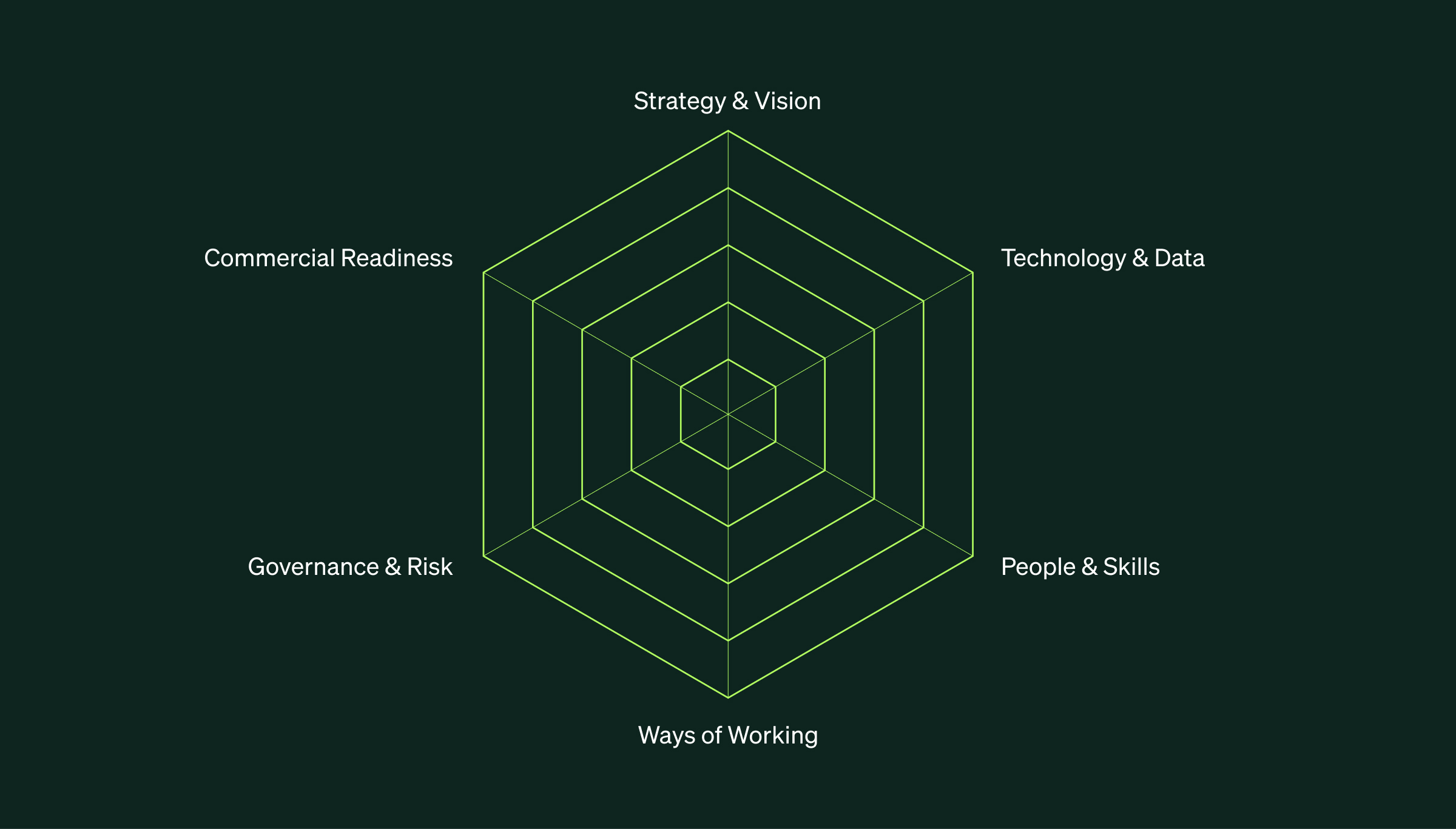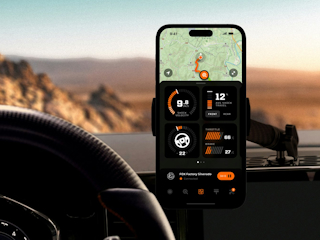Dive into our latest blog post to explore the case for disruption, the path from vision to velocity and the steps to scale AI responsibly and with confidence.
The case for disruption
The AI revolution
We stand at the precipice of a revolution. AI is not just another tool in the digital toolbox. It is changing how businesses operate, compete, and create value. Many clients are asking the same question: are we ready for this shift, or will we get left behind?
Adoption vs maturity
On the surface, adoption looks strong. Almost 8 in 10 companies are already experimenting with AI in some form. But here’s the sobering reality: fewer than 5 percent have moved beyond pilots into scaled deployments, and very few would call their programs mature. The gap between adoption and maturity is where businesses risk falling behind. Many organizations mistake experimentation for progress, creating a false confidence. The reality is lots of activity, but very little impact.
Why the gap creates risk
The risk isn’t that you don’t use AI. Almost everyone does at some level. The real risk is falling behind the pace of your competitors. Leaders are those who turn adoption into outcomes faster, creating new benchmarks for customer experience and efficiency. Standing still in this race is the same as moving backwards.
Unlocking disruption
When we talk about disruption, we mean the moment when established ways of working are overtaken by something faster, smarter, or more valuable. Disruption is not just about technology. It is about business models, customer expectations, and the ability to adapt. Unlocking disruption means moving beyond incremental improvements to explore how AI can change the rules in your industry. Companies that unlock disruption early are the ones who define the pace, while others are forced to follow.
Traditional strategies are challenged by time horizons
Traditional strategies often take a future-back approach. They set ambitious visions for what the business could look like in five or ten years, but fail to equip teams with the means to act today. This creates a gap between aspiration and execution. To succeed with AI, organizations must balance the future-back perspective with small, targeted initiatives that deliver momentum and build confidence now.
Optimization vs disruption
Optimization keeps the lights on, but it rarely changes the game. Disruption is where step-change growth and differentiation occur. Companies that only optimize risk being overtaken by competitors who are willing to disrupt their own models and embrace new ways of creating value.
Building the foundations for AI readiness
To succeed with AI, organizations need three core enablers.
-
Foundation is the bedrock: technology, data and architecture.
-
Enablement is how people and operating models turn AI into practice.
-
Direction ensures strategy, governance and commercial readiness guide the journey.
Together, these expand into six readiness pillars (see below) that we use to assess maturity. Without these layers in place, AI adoption risks stalling before it delivers impact.
From vision to velocity
Innovate with purpose
Innovation alone is not enough. AI brings enormous potential, but without purpose it risks becoming a series of disconnected experiments. To succeed, organizations must connect their vision for the future with the velocity to act today. Innovating with purpose means outpacing your competitors, moving faster up the maturity journey and translating ambition into measurable outcomes. This is the shift from vision to velocity.
AI maturity ladder
Every organization is somewhere on the AI maturity ladder. Explorers are curious about AI but lack a clear strategy. Experimenters run pilots and proofs of concept, but they are not scaled. Integrators start embedding AI into workflows and introduce basic governance. Scalers move further, embedding AI across business units to realize measurable value. At the top are Transformers, where AI becomes a driver of new business models and sustained competitive advantage. The challenge for leaders is not whether they are on this ladder, but how quickly they can move up it compared to their peers.
The adoption vs readiness gap
Adoption of AI is high, with most organizations experimenting through pilots, generative AI, or emerging AI agents. But readiness is low. Less than 1 percent of generative AI rollouts are mature, only 5 percent of pilots reach production, and fewer than half of organizations prioritize governance. This imbalance is where most organizations stall, stuck between Experimenter and Integrator on the maturity journey. Closing the gap requires more than technology. It demands new ways of working, governance, and commercial models to turn adoption into outcomes.
The six pillars of AI readiness
AI readiness isn’t a single capability. It’s a system. We break it into six measurable pillars that together define how prepared an organization is to scale AI with impact. These pillars span the foundation of technology and commercial readiness, the enablers of people and ways of working, and the directional elements of strategy and governance. When these six areas are aligned, organizations move from experimentation to transformation. When they’re not, progress stalls, no matter how much adoption you see in isolated pockets.

Assessing your readiness
Readiness is not an abstract idea. It is measurable. By assessing across the six pillars, we can identify where an organization is strong and where it risks stalling. Some score high on vision and technology but struggle with governance. Others have strong people and skills but lack commercial readiness to scale. The power of this view is that it turns AI into a structured conversation. It highlights strengths, exposes blind spots, and creates a roadmap for where to invest next. This is not about chasing shiny tools. It is about building a balanced system that can scale AI safely and with impact.
Mapping the path to scale
AI readiness is not an end in itself. The real challenge and opportunity are moving from potential to value creation. This framework helps us break that down. At the center is the outcome we care about, whether it is winning new customers, delivering better service or creating smarter operations. Around it we map the specific jobs to be done, the actors involved, and the role AI can play in each step. This creates a structured way to identify and prioritize use cases that are both high impact and feasible to scale. By evolving the framework continuously we ensure that AI is not just experimented with in pockets but embedded where it matters most. This is how readiness turns into results.
From experiments to scale
The POC trap: Where momentum stalls
Most organizations begin their AI journey with speed and excitement. Ideas are turned into proofs of concept in hours, often showing impressive early results. But this is where momentum almost always stalls. Moving from POC to production demands security, compliance, scalability, performance, and integration into real workflows. Without a clear path, experiments pile up and value creation flatlines. This is the POC trap, the reason 98 percent of organizations remain stuck experimenting while only a small fraction manage to scale.
Every use case must earn its way to scale
Scaling AI is not just a technical challenge. It is an organizational one. Clear roles and responsibilities are required at every stage: business leads to define the opportunity, innovation leads to drive experimentation, project managers to run pilots and governance functions to provide risk, compliance and integration into the AI foundation. When ownership is fragmented, scaling fails. When ownership is clear, AI becomes embedded, accountable and value-generating. Successful organizations make scaling a team sport with clear lines of responsibility.
Clear ownership is the key to AI scaling
Scaling AI requires more than technology. It requires clear accountability at every stage. Ideas start with business leads, are tested by innovation teams, stress-tested by project managers and ultimately scaled by leaders who embed AI into the operating model. Surrounding this progression are the enablers that make scaling possible through tools, governance and a strong AI foundation. When ownership is fragmented, AI remains a science project. When it is clear, AI becomes a source of business value.
The AI era rewards those who move beyond experimentation and establish the foundation, enablement and direction that allow AI to scale with measurable outcomes. At Valtech, we partner with brands to navigate this journey: balancing innovation with governance and translating ambition into results.
Where is your organization on the AI maturity journey?
Take our AI Readiness Assessment to evaluate your readiness across six pillars. Answer 21 questions and receive a detailed breakdown of your organization’s AI maturity including strengths, gaps and priorities for scaling with confidence.












